
- CN 62-1070/P
- ISSN 1000-694X
- Bimonthly 1981

Journal of Desert Research ›› 2024, Vol. 44 ›› Issue (3): 158-171.DOI: 10.7522/j.issn.1000-694X.2023.00128
Junyan Chen( ), Yawen Guan, Yue Zhang, Yu Chen, Hongru Bi, Gaotong Lou, Xinyang Guo, Yang Wang, Siyu Chen(
), Yawen Guan, Yue Zhang, Yu Chen, Hongru Bi, Gaotong Lou, Xinyang Guo, Yang Wang, Siyu Chen( )
)
Received:2023-06-11
Revised:2023-12-29
Online:2024-05-20
Published:2024-06-11
Contact:
Siyu Chen
CLC Number:
Junyan Chen, Yawen Guan, Yue Zhang, Yu Chen, Hongru Bi, Gaotong Lou, Xinyang Guo, Yang Wang, Siyu Chen. Transport of dust from Gobi Desert to the Tibetan Plateau and its dynamic mechanism: a case study of a dust event in April of 2020[J]. Journal of Desert Research, 2024, 44(3): 158-171.
Add to citation manager EndNote|Ris|BibTeX
URL: http://www.desert.ac.cn/EN/10.7522/j.issn.1000-694X.2023.00128
| 大气过程 | 具体过程 | 参考文献来源 |
|---|---|---|
| 物理过程 | 陆面过程 | Chen等[ |
| 边界层 | Hong等[ | |
| 积云对流 | Grell等[ | |
| 云微物理 | Thompson等[ | |
| 长/短波辐射 | Iacono等[ | |
| 起沙过程 | Ginoux等[ | |
| 化学过程 | 气溶胶化学 | Ginoux等[ |
Table 1 Parametric scheme settings
| 大气过程 | 具体过程 | 参考文献来源 |
|---|---|---|
| 物理过程 | 陆面过程 | Chen等[ |
| 边界层 | Hong等[ | |
| 积云对流 | Grell等[ | |
| 云微物理 | Thompson等[ | |
| 长/短波辐射 | Iacono等[ | |
| 起沙过程 | Ginoux等[ | |
| 化学过程 | 气溶胶化学 | Ginoux等[ |
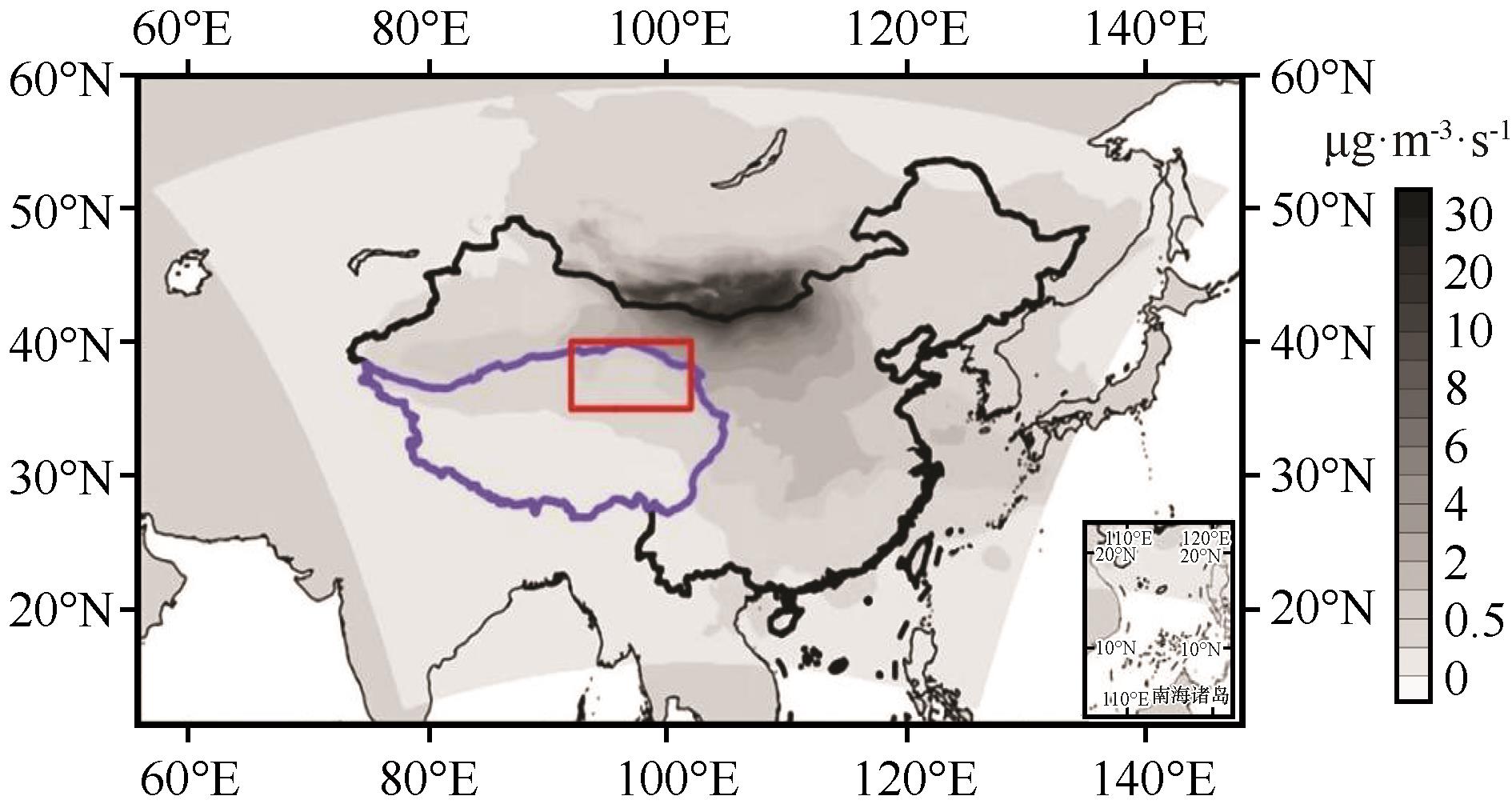
Fig.1 Average sand emission flux simulated by WRF-Chem in the Gobi Desert during April 14-19, 2020. The box indicates the main area where dust was transported to the Tibetan Plateau (35°-40°N, 92°-102°E) during this dust event. These include the main dust coverage area on the north slope (35°-40°N,92°-96°E) and the main dust coverage area on the east slope (35°-40°N, 99°-102°E)
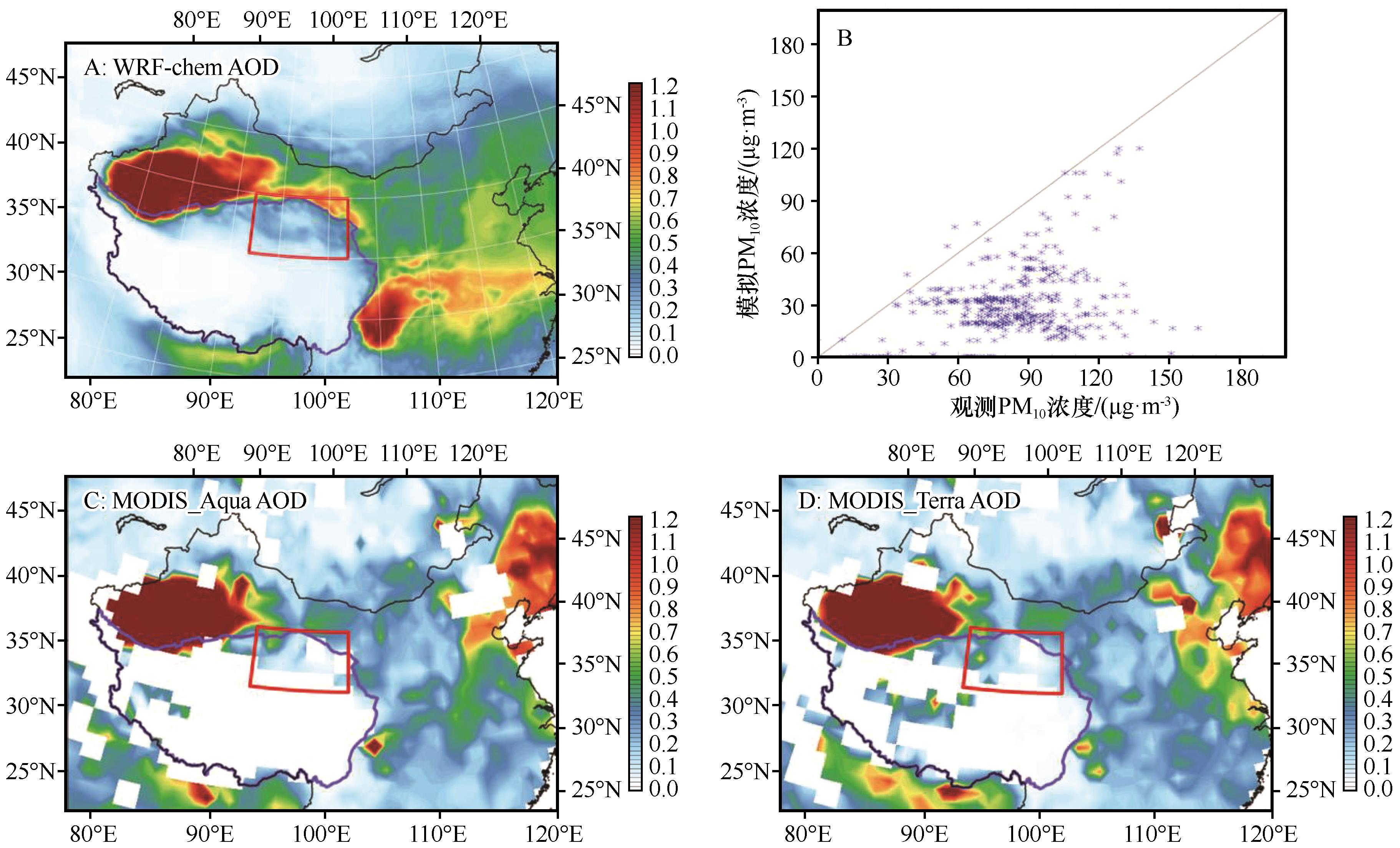
Fig.2 Comparison of WRF-chem AOD (A), MODIS_Aqua AOD (C), and MODIS_Terra AOD (D) during April 14-19, 2020,and comparison between the daily average PM10 concentration and PM10 concentration simulated by WRF-chem at most stations in northern China (30°-50°N, 80°-120°E, B)
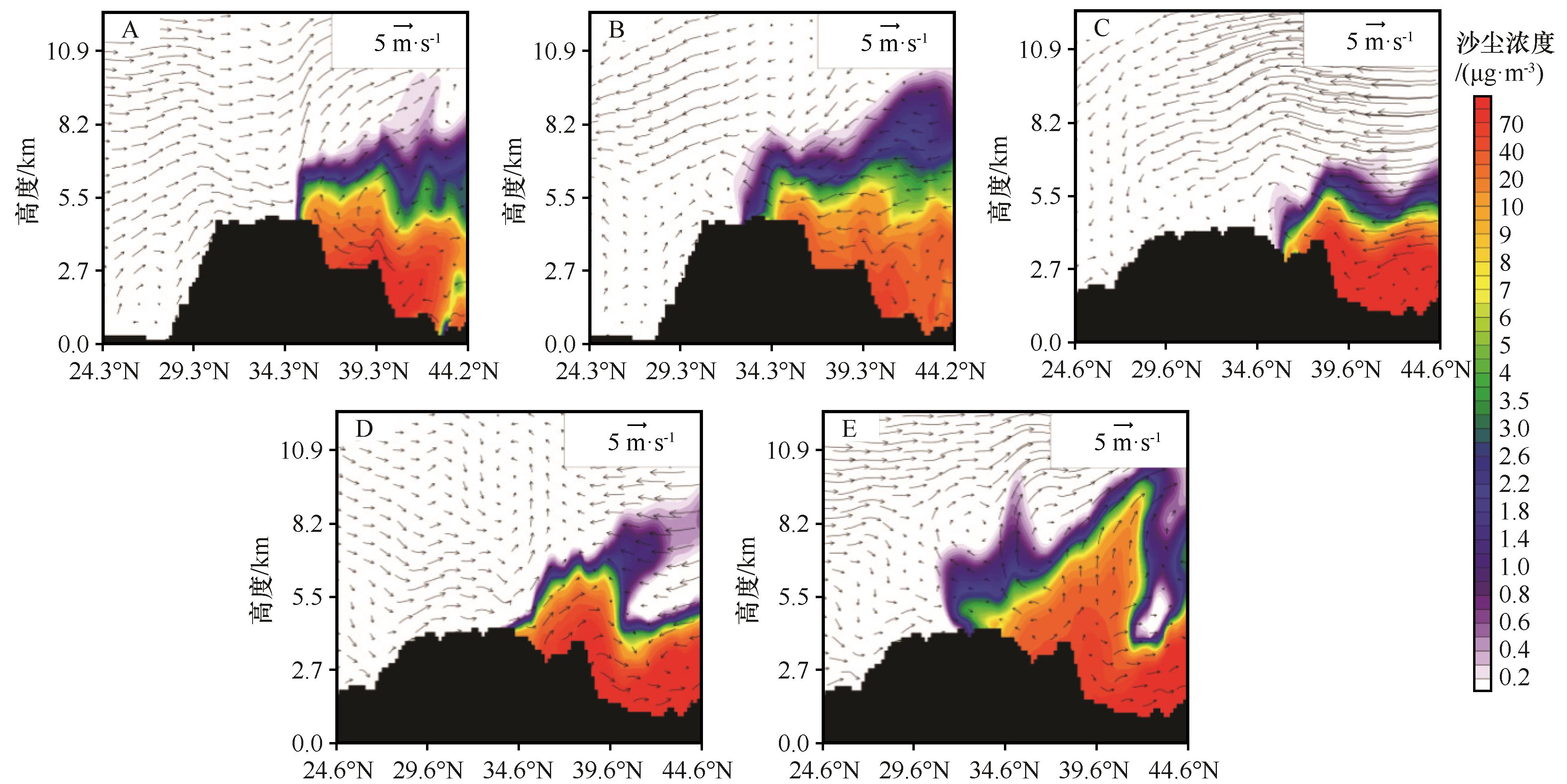
Fig.7 The meridional section of Gobi Desert dust transport to the Tibet Plateau over the north slope of the Tibetan Plateau on April 16th (A), 17th (B), and over the east slope of the Tibetan Plateau on April 15th (C), 16th (D), 17th (E)

Fig.8 The 96 h dust HYSPLIT backward trajectories at 00:00 on April 17, 2020 (UTC) of the east (36°N, 100°E, A) and north (37°N, 95°E, B) slopes of the Tibetan Plateau affected by dust this time, and the 120 h dust HYSPLIT forward trajectories of Daranzadegade station (43.57°N, 104.43°E) on April 14th, 2020
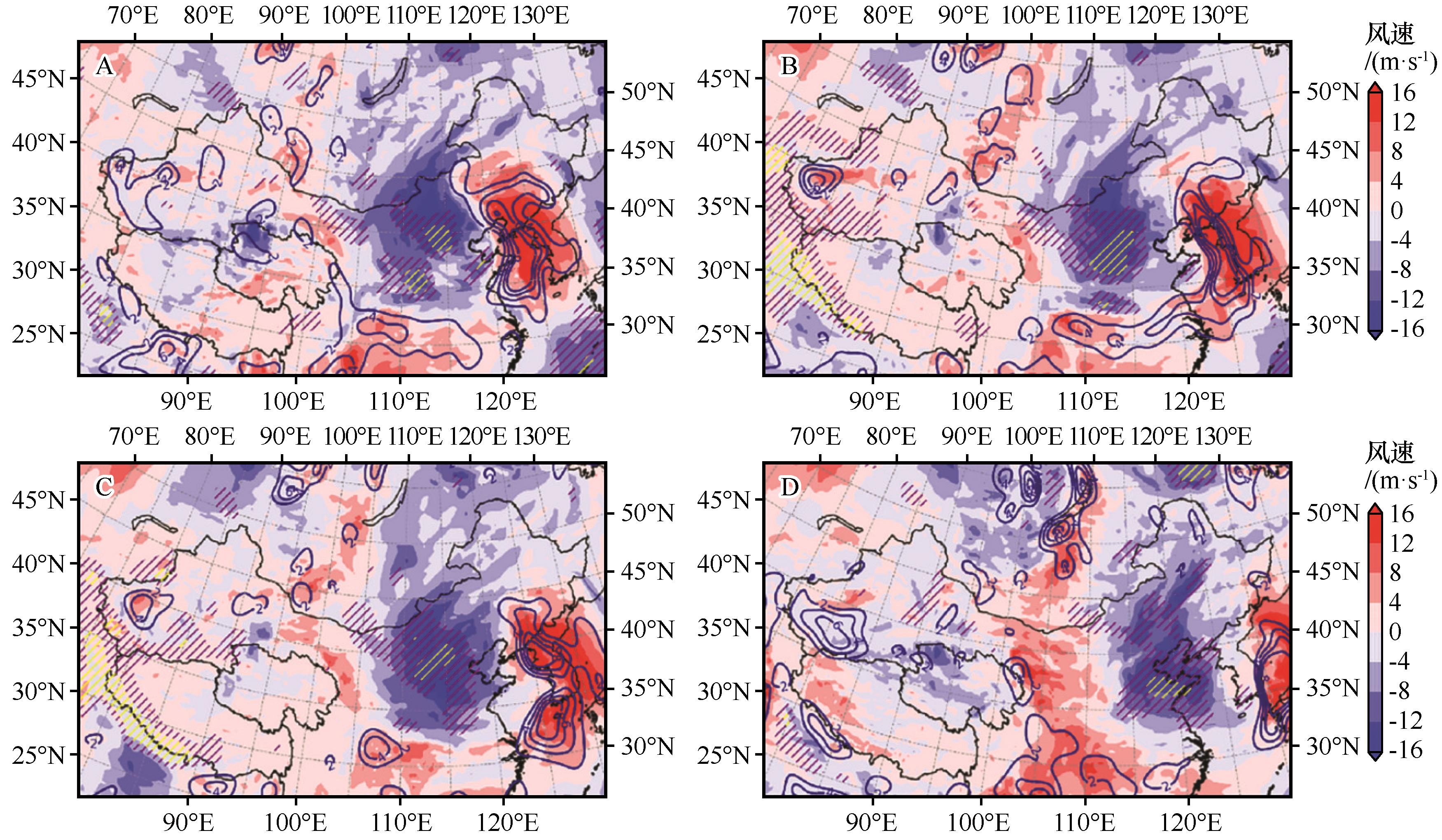
Fig.9 Meridional wind speed field at 12:00 (A) and 18:00 (B) on April 16th, and at 00:00 (C) and 06:00(D) on April 17th (blue indicates north wind, red indicates south wind, unit m·s-1, horizontal resolution 0.25°×0.25°. The blue contour line indicates the rising area with a vertical velocity greater than or equal to 0.02 m·s-1, the contour interval is 0.02 m·s-1, the slash is the sinking area, the purple indicates the vertical velocity from -0.04 m·s-1 to -0.02 m·s-1, and the yellow indicates vertical speed from -0.08 m·s-1 to -0.04 m·s-1
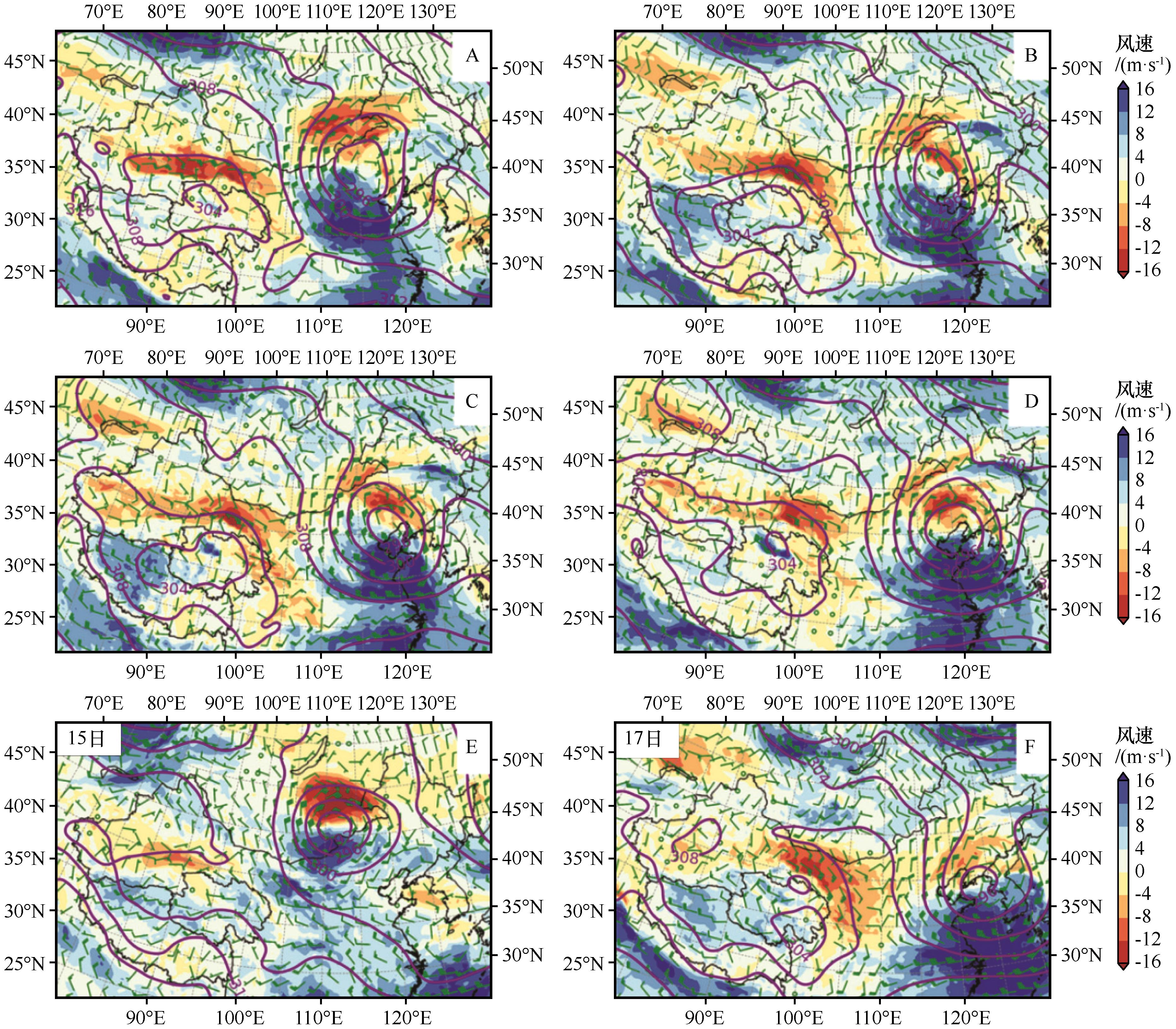
Fig.10 The 700 hPa geopotential height (purple line, unit dagpm) and zonal wind speed (blue indicates west wind, red indicates east wind, unit m·s-1, horizontal resolution 0.25°× 0.25°) at 00:00 (A), 06:00 (B), 12:00 (C), 18:00 (D) on April 16th, 15th (E) and 17th (F)
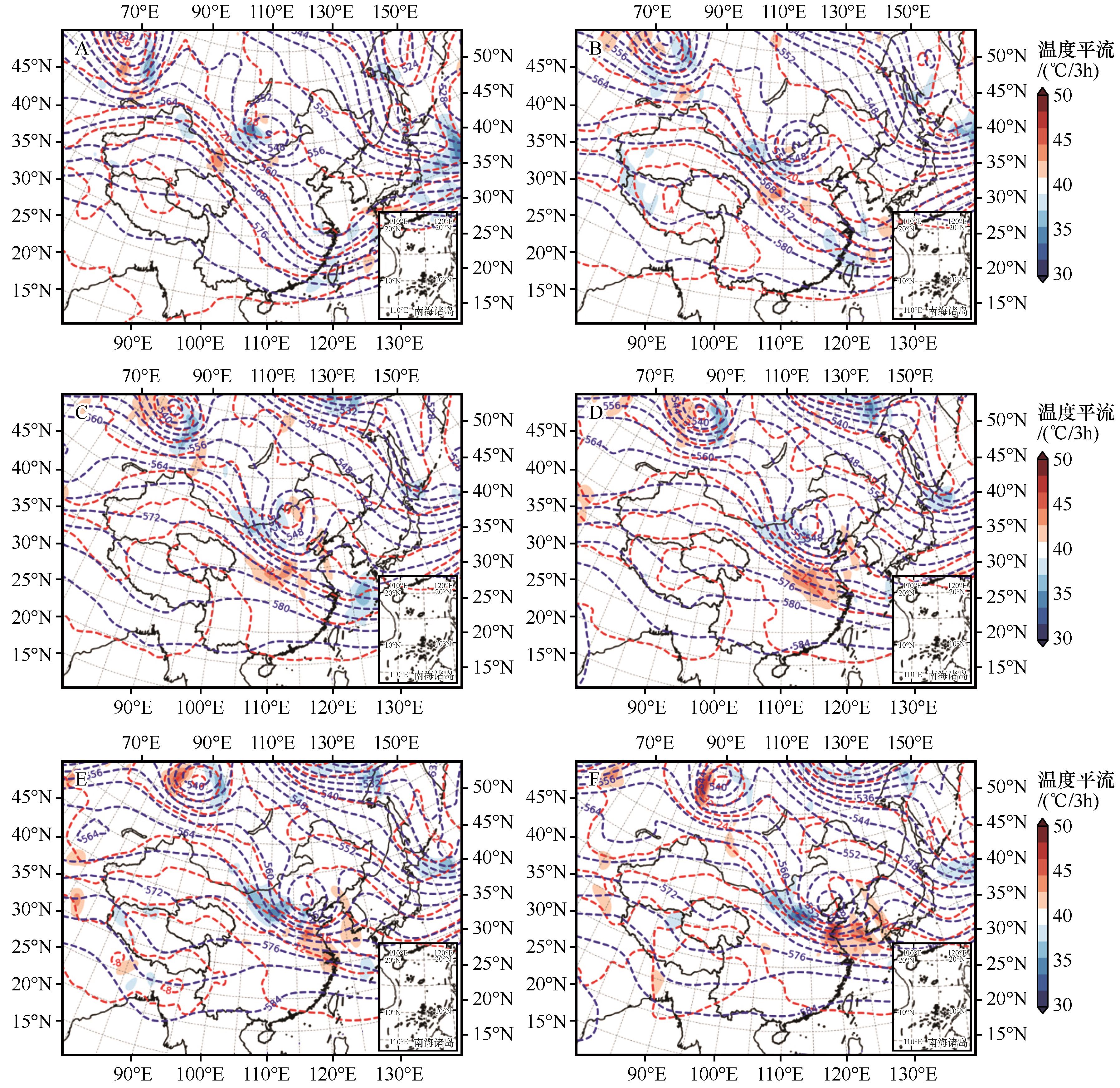
Fig.11 The 500 hPa geopotential height (blue contour, unit is dagpm) and temperature advection (the red area is warm advection, and the blue area is cold advection, unit ℃/3h) at 00:00 (A), 12:00 on April 15th (B) and 00:00 (C), 06:00 (D), 12:00 (E), 18:00 (F) on April 16th
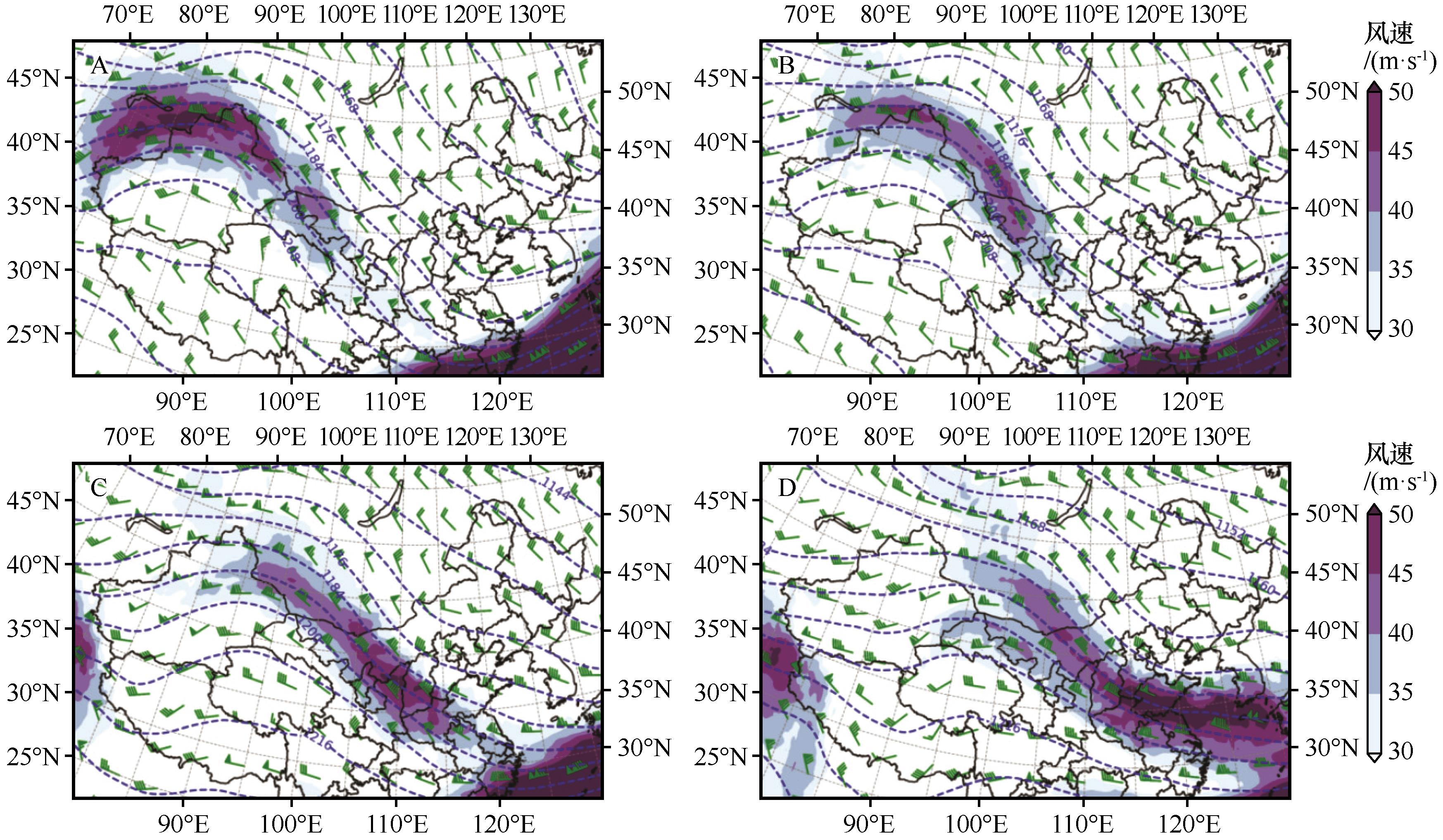
Fig.12 The 200 hPa jet stream (wind speed in the colored area is greater than 30 m·s-1) and geopotential height (blue dotted contour line, unit dagpm) at 00:00 (A), 06:00 (B) on April 15th, 06:00 (C), 18:00 (D) on April 16th
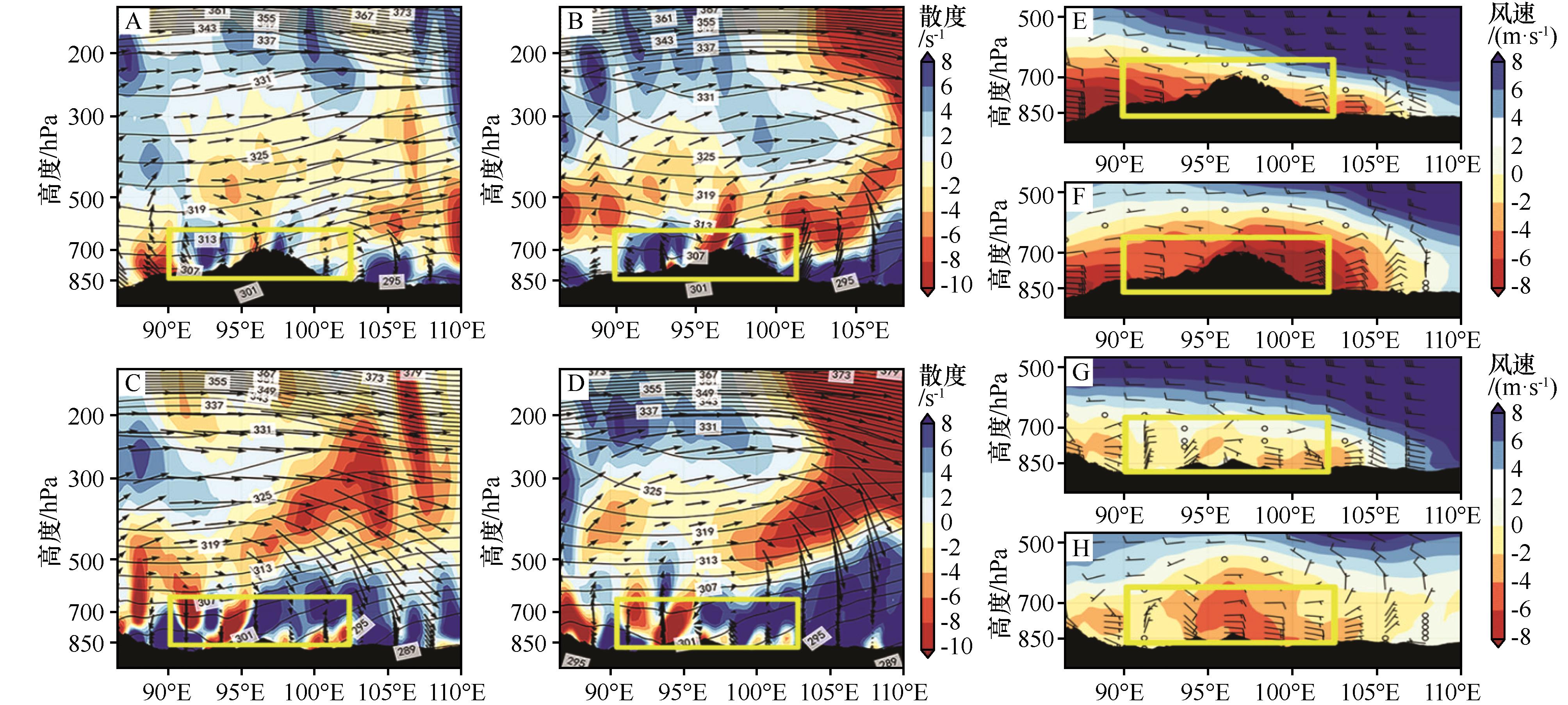
Fig.13 The vertical profiles of the average potential temperature (black lines), divergence (red indicates the convergence area, unit is s-1), the flow field (vector arrow) on April 15th (A) and 16th (B), and the wind speed (the red area is easterly, unit is m·s-1) and the synthetic wind vector on April 15th (E) and 16th (F) over the Hexi Corridor-Qilian Mountains (38°-41°N); The vertical profiles of the average potential temperature (black lines), divergence (red indicates the convergence area, unit is s-1), the flow field (vector arrow) on April 15th (C) and 16th (D), and the wind speed (the red area is easterly, unit is m·s-1) and the synthetic wind vector on April 15th (G) and 16th (H) over the western Gobi Desert of Mongolia (41°-44°N)
| 1 | Huang J, Yu H, Guan X,et al.Accelerated dryland expansion under climate change[J].Nature Climate Change,2016,6(2):166-171. |
| 2 | Huang J, Yu H, Dai A,et al.Drylands face potential threat under 2 C global warming target[J].Nature Climate Change,2017,7(6):417-422. |
| 3 | Gillette D.Soil derived dust as a source of silica:aerosol properties,emissions,deposition,and transport[J].Journal of Exposure Analysis and Environmental Epidemiology,1997,7(3):303-311. |
| 4 | Houser C A, Nickling W G.The emission and vertical flux of particulate matter <10 μm from a disturbed clay‐crusted surface[J].Sedimentology,2001,48(2):255-267. |
| 5 | Middleton N J.Desert dust hazards:a global review[J].Aeolian Research,2017,24:53-63. |
| 6 | Miller O L, Solomon D K, Fernandez D P,et al.Evaluating the use of strontium isotopes in tree rings to record the isotopic signal of dust deposited on the Wasatch Mountains[J].Applied Geochemistry,2014,50:53-65. |
| 7 | Schepanski K.Transport of mineral dust and its impact on climate[J].Geosciences,2018,8(5):151. |
| 8 | Schulz M, Prospero J M, Baker A R,et al.Atmospheric transport and deposition of mineral dust to the ocean:implications for research needs[J].Environmental Science & Technology,2012,46(19):10390-10404. |
| 9 | Kurt-Karakus P B.Determination of heavy metals in indoor dust from Istanbul,Turkey:estimation of the health risk[J].Environment International,2012,50:47-55. |
| 10 | Zhang X Y, Gong S L, Zhao T L,et al.Sources of Asian dust and role of climate change versus desertification in Asian dust emission[J].Geophysical Research Letters,2003,30(24):018206. |
| 11 | Zhang X Y, Arimoto R, An Z S.Dust emission from Chinese desert sources linked to variations in atmospheric circulation[J].Journal of Geophysical Research:Atmospheres,1997,102(D23):28041-28047. |
| 12 | Huang J, Minnis P, Chen B,et al.Long‐range transport and vertical structure of Asian dust from CALIPSO and surface measurements during PACDEX[J].Journal of Geophysical Research:Atmospheres,2008,113(D23):010620. |
| 13 | Huang J, Minnis P, Lin B,et al.Possible influences of Asian dust aerosols on cloud properties and radiative forcing observed from MODIS and CERES[J].Geophysical Research Letters,2006,33(6):024724. |
| 14 | Qian Y, Flanner M, Leung L R,et al.Sensitivity studies on the impacts of Tibetan Plateau snowpack pollution on the Asian hydrological cycle and monsoon climate[J].Atmospheric Chemistry and Physics,2011,11:1929-1948. |
| 15 | Chen S, Huang J, Kang L,et al.Emission,transport and radiative effects of mineral dust from Taklimakan and Gobi Deserts:comparison of measurements and model results[J].Atmospheric Chemistry and Physics,2017,17(3):1-43. |
| 16 | Vova O, Kappas M, Renchin T,et al.Land degradation assessment in Gobi-Altai province[J].Building Resilience of Mongolian Rangelands,2015,2(1):54. |
| 17 | 李晓岚,张宏升.2010年春季北京地区强沙尘暴过程的微气象学特征[J].气候与环境研究,2012,17(4):400-408. |
| 18 | Dagvadorj D.Mongolia second national communication under the United Nations framework convention on climate change[R].Ulaanbaatar,Mongolia:Ministry of Nature,Environment and Tourism,2010. |
| 19 | 张凯,高会旺,张仁健,等.我国沙尘的来源、移动路径及对东部海域的影响[J].地球科学进展,2005,20(6):627-636. |
| 20 | Kai Z, Huiwang G.The characteristics of Asian-dust storms during 2000-2002:from the source to the sea[J].Atmospheric Environment,2007,41(39):9136-9145. |
| 21 | 罗勇.青藏高原冬春季雪盖对东亚夏季大气环流影响的研究[J].高原气象,1995,14(4):505-512. |
| 22 | Shichang K, Wake C P, Dahe Q,et al.Monsoon and dust signals recorded in Dasuopu glacier,Tibetan Plateau[J].Journal of Glaciology,2000,46(153):222-226. |
| 23 | Kang S, Xu Y, You Q,et al.Review of climate and cryospheric change in the Tibetan Plateau[J].Environmental Research Letters,2010,5(1):015101. |
| 24 | Chen S Y, Zhao C, Qian Y,et al.Regional modeling of dust mass balance and radiative forcing over East Asia using WRFChem[J].Aeolian Research,2014,15:15-30. |
| 25 | Chen S, Huang J, Qian Y,et al.An overview of mineral dust modeling over East Asia[J].Journal of Meteorological Research,2017,31(4):633-653. |
| 26 | 韩永翔,奚晓霞,宋连春,等.青藏高原沙尘及其可能的气候意义[J].中国沙漠,2004,24(5):588-592. |
| 27 | 马耀明,胡泽勇,田立德,等.青藏高原气候系统变化及其对东亚区域的影响与机制研究进展[J].地球科学进展,2014,29(2):207-215. |
| 28 | Huang J, Ge J, Weng F.Detection of Asia dust storms using multisensor satellite measurements[J].Remote Sensing of Environment,2007,110(2):186-191. |
| 29 | Chen Y, Chen S, Zhao D,et al.The role of boundary layer height in India on transboundary pollutions to the Tibetan Plateau[J].Science of The Total Environment,2022,837:155816. |
| 30 | Chen S, Huang J, Zhao C,et al.Modeling the transport and radiative forcing of Taklimakan dust over the Tibetan Plateau:a case study in the summer of 2006[J].Journal of Geophysical Research:Atmospheres,2013,118(2):797-812. |
| 31 | Feng X, Mao R, Gong D Y,et al.Increased dust aerosols in the high troposphere over the Tibetan Plateau from 1990s to 2000s[J].Journal of Geophysical Research:Atmospheres,2020,125(13):032807. |
| 32 | DeFries R S, Townshend J R G.NDVI-derived land cover classifications at a global scale[J].International Journal of Remote Sensing,1994,15(17):3567-3586. |
| 33 | Kim D, Chin M, Bian H,et al.The effect of the dynamic surface bareness on dust source function,emission,and distribution[J].Journal of Geophysical Research:Atmospheres,2013,118(2):871-886. |
| 34 | Kim D, Chin M, Remer L A,et al.Role of surface wind and vegetation cover in multi-decadal variations of dust emission in the Sahara and Sahel[J].Atmospheric Environment,2017,148:282-296. |
| 35 | Ginoux P, Chin M, Tegen I,et al.Sources and distributions of dust aerosols simulated with the GOCART model[J].Journal of Geophysical Research:Atmospheres,2001,106(D17):20255-20273. |
| 36 | Grell G A, Peckham S E, Schmitz R,et al.Fully coupled “online” chemistry within the WRF model[J].Atmospheric Environment,2005,39(37):6957-6975. |
| 37 | Chen F, Dudhia J.Coupling an advanced land surface-hydrology model with the Penn State-NCAR MM5 modeling system.Part I:model implementation and sensitivity[J].Monthly Weather Review,2001,129(4):569-585. |
| 38 | Hong S Y, Noh Y, Dudhia J.A new vertical diffusion package with an explicit treatment of entrainment processes[J].Monthly Weather Review,2006,134(9):2318-2341. |
| 39 | Grell G A, Dévényi D.A generalized approach to parameterizing convection combining ensemble and data assimilation techniques[J].Geophysical Research Letters,2002,29(14):38-1-38-4. |
| 40 | Thompson G, Rasmussen R M, Manning K.Explicit forecasts of winter precipitation using an improved bulk microphysics scheme.Part I:description and sensitivity analysis[J].Monthly Weather Review,2004,132(2):519-542. |
| 41 | Iacono M J, Delamere J S, Mlawer E J,et al.Radiative forcing by long‐lived greenhouse gases:calculations with the AER radiative transfer models[J].Journal of Geophysical Research:Atmospheres,2008,113(D13):009944. |
| [1] | Jialong Ren, Jiliang Liu, Yongzhen Wang, Jing Fang, Yilin Feng, Anling Gao, Yuanxia Song, Weidong Xin. Response of ground arthropod assemblages to precipitation and temperature changes in the gobi desert [J]. Journal of Desert Research, 2024, 44(2): 207-219. |
| [2] | Jiahui Cao, Siyu Chen, Chao Zhang, Lulu Lian, Dan Zhao, Shikang Du. External contribution of the Tibetan Plateau dust [J]. Journal of Desert Research, 2024, 44(2): 57-65. |
| [3] | Haokun Mo, Guangyin Hu, Huicong Meng. Research progress on aeolian activity in the Qinghai Lake area, northeastern Tibetan Plateau [J]. Journal of Desert Research, 2023, 43(6): 197-209. |
| [4] | Zhulei Dong, Xuegong Jiang, Nana Yi, Zhili Xu, Yuehe Hang, Shuiyan Yu. Numerical simulation of the influence of wind speed and vegetation on dust weather in Inner Mongolia, China [J]. Journal of Desert Research, 2023, 43(6): 29-39. |
| [5] | Yayun Li, Wei Cheng, Ning Wang, Xin Li, Rui Gao. Comparative study on the characteristic of spring sandstorms and the related meteorological factors of the Taklimakan Desert and Gobi Desert [J]. Journal of Desert Research, 2023, 43(4): 1-9. |
| [6] | Mengjun Hu, Jing Zhuang, Wenli Sun, Dengyou Zheng, Tianqi Ji, Aokang Xu. Geochemical characteristics of major elements and environmental evolution in the Holocene in the northeastern Tibetan Plateau [J]. Journal of Desert Research, 2023, 43(2): 11-20. |
| [7] | Aihua Hao, Xian Xue, Quangang You, Chaoyang Gou. Review on precipitation change over the Qinghai-Tibetan Plateau in recent 60 years [J]. Journal of Desert Research, 2023, 43(2): 43-52. |
| [8] | Jingjing Hu, Guangyin Hu, Zhibao Dong. Particle size characteristics of aeolian desertified land in Madoi Basin of the source region of Yellow River [J]. Journal of Desert Research, 2022, 42(4): 242-252. |
| [9] | Siyu Chen, Yawen Guan, Dan Zhao, Gaotong Lou, Yu Chen. Influence of dust aerosol on land surface diurnal temperature range over East Asia Simulated with the WRF-Chem model [J]. Journal of Desert Research, 2022, 42(3): 127-138. |
| [10] | Fangming Zeng, Hongpan Xue. The dataset of elemental compositions of the late Pleistocene loess-paleosol deposits on the northeastern Tibetan Plateau [J]. Journal of Desert Research, 2021, 41(6): 262-264. |
| [11] | Jiliang Liu, Wenzhi Zhao, Fengrui Li, Yibin Ba. Community dynamics of ground arachnid arthropods in a gravel gobi desert of the middle of the Hexi Corridor, China [J]. Journal of Desert Research, 2021, 41(3): 155-164. |
| [12] | Guangyin Hu, Zhibao Dong, Zhengcai Zhang, Ming Zhou, Lunyu Shang. The regime of sand driving wind and sand drift potential in Zoige Basin [J]. Journal of Desert Research, 2020, 40(5): 20-24. |
| [13] | Yi Nana, Jiang Xuegong, Dong Zhulei, Yu Shuiyan, Kang Shengwei. Numerical simulation of a dust process in Inner Mongolia of China [J]. Journal of Desert Research, 2020, 40(3): 115-126. |
| [14] | Pan Kaijia, Zhang Zhengcai, Liang Aimin, Dong Zhibao, Li Xingcai. Nebkhas geomorphology in the gobi desert using the unmanned aerial vehicle and tilt camera [J]. Journal of Desert Research, 2020, 40(2): 24-32. |
| [15] | Zhang Zhijuan, Yi Yuhong, Chen Bin, Du Hui. Effectof Dust Weather on Urban Air Quality over Northern China in Spring of 2018 and its Weather Analysis [J]. Journal of Desert Research, 2019, 39(6): 13-22. |
| Viewed | ||||||
|
Full text |
|
|||||
|
Abstract |
|
|||||
©2018Journal of Desert Research
Tel:0931-8267545
Email:caiedit@lzb.ac.cn;desert@lzb.ac.cn
Support:Magtech